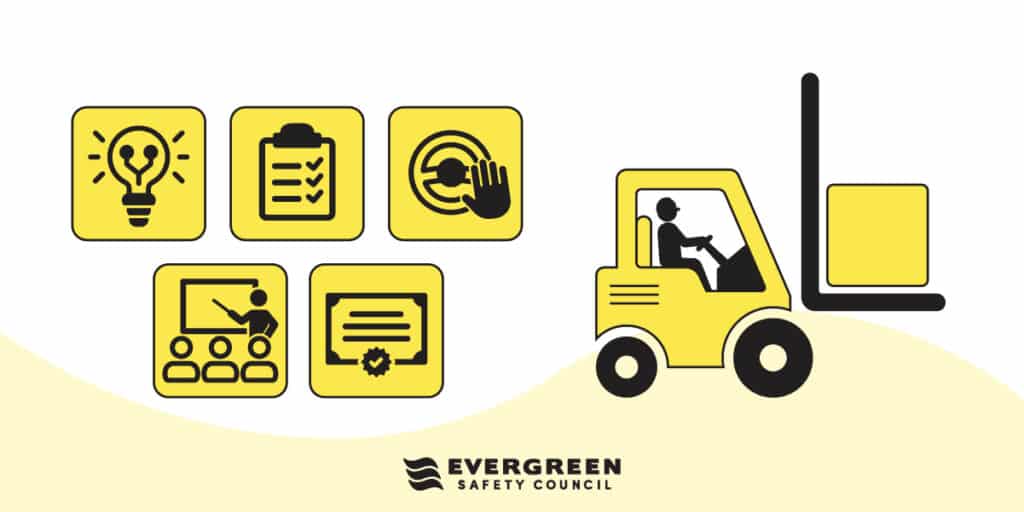If your team members operate a forklift or other type of Powered Industrial Truck (PIT), you’ve probably thought about getting them officially trained. Maybe you do some basic orientation, but unless your organization or business already has a custom training program in place, figuring out how to train them according to OSHA standards might be intimidating.
Training your forklift operators per OSHA standards could be simpler than you think.
According to federal regulations, there are five key things that operators need in order to become officially “certified.” (Even if your state has its own Health and Safety department, the OSHA standards for forklift operation are still the highest as far safety in this arena.)
Step 1: Provide your operators with good knowledge training.
OSHA standards require a “formal instruction” component, such as “lecture, discussion, interactive computer learning, video tape, [or] written material.” A self-directed online course is one easy way to fulfill this requirement. You may alternatively choose to deliver the material in a more traditional classroom-based format, with a slide deck, textbooks, and exams.
Step 2: Conduct a safety audit of your facility to assess forklift hazards.
Check for any areas that would be dangerous for operators, pedestrians, objects, or equipment, and think about the types of activities that will be carried out using the forklift. OSHA standards list the following:
- Surface conditions where the vehicle will be operated
- Composition of loads to be carried
- Types of load manipulation, stacking, and unstacking
- Pedestrian traffic in areas where the vehicle will be operated
- Narrow aisles and other restricted places where the vehicle will be operated
- Hazardous locations where the vehicle will be operated (such as areas with flammable materials)
- Ramps and other sloped surfaces that could affect the vehicle’s stability
- Closed environments and other areas where insufficient ventilation or poor vehicle maintenance could cause a buildup of carbon monoxide or diesel exhaust
- Any other potentially hazardous environmental conditions that could affect safe operation
Step 3: Make sure you are familiar with the forklift or other Powered Industrial Truck that you will be training on.
Each operator will need to be trained and certified on the forklift (or other Powered Industrial Truck, such as a pallet jack or lift) that they will be using on the job. PITs may operate on similar principles, but each one has its own unique features. This means that prior to training, you should familiarize yourself with the specifics of the machines you’ll be teaching your operators to use. This includes the operating instructions, warnings, and precautions that are included in the manual, the truck controls and instrumentation, and other features such as fueling and fork attachment.
If you have multiple types of PITs at your facility, you will need to know the ins and outs of each one, and make sure your operators receive training on them separately.
Step 4: Understand how to conduct effective practical training for your team.
Good learning happens under good trainers, and becoming a good trainer takes practice. Develop a training plan and follow it each time so that you stay consistent. OSHA requires that you evaluate your operators, so it is good to have a written evaluation sheet where you can track each operator’s performance. When showing them how to operate each PIT, first demonstrate each skill, then allow each operator to practice carefully while you coach them. Depending on their experience level, they may not need any help at all, or they may need additional practice before they are cleared to operate on their own.
Step 5: Keep a record of certification for each operator, and retrain as needed.
OSHA standards require that you keep a log of training and certification for each operator. We recommend keeping this in a spreadsheet, but you can also use a written or typed log, as long as it is somewhere safe and accessible. Operators are required to be reevaluated every 3 years, but they should also receive refresher training if they are observed operating in an unsafe manner, have been involved in an accident or near-miss incident, need to drive a different type of PIT that they have not been previously trained on, or workplace conditions change in a manner that could affect safe operation of the truck.
But am I qualified?
If you have knowledge of and experience with operating a PIT, and you are willing to complete the 5 steps above, then yes, you are qualified to be a trainer at your workplace!
Good training means long-run savings.
Organizations and businesses need their teams operating safely and efficiently, and it all starts with the right training.
Not sure you’re comfortable becoming a trainer on your own? If you’re in the Pacific Northwest region, our master trainers are skilled coaches who can come help get you up to speed, usually in just one day. They’ll come to your facility to conduct a hazard analysis, and guide you through the process of practical training for your employees so that you can confidently do it yourself.
If you are looking for a little bit more guidance, but you don’t need one-on-one coaching, our PDF instructor kit contains everything we discussed in this article, including a workplace hazard evaluation sheet, practical operator evaluation sheet, and certification record spreadsheet, as well as detailed instructions on how to conduct your training — plus 5 free seats in our online knowledge course.
